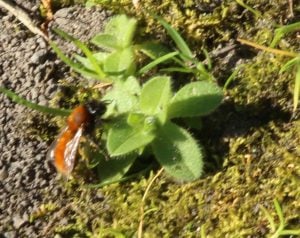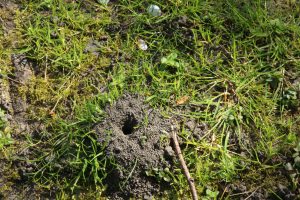While some of our students are coming into college during the first week of the Easter holiday to attend revision sessions, a colony of tawny miner bees have been busy making themselves at home on our leafy campus amongst our bug hotels.
 The tawny miner bee, scientifically known as Andrena fulva, is a solitary bee species easily identifiable by its striking ginger fur and industrious nature. These bees are typically seen from April to June, coinciding with the blooming of fruit trees. Unlike their social counterparts, tawny miner bees prefer to work alone, digging individual burrows in the soil to lay their eggs.
The tawny miner bee, scientifically known as Andrena fulva, is a solitary bee species easily identifiable by its striking ginger fur and industrious nature. These bees are typically seen from April to June, coinciding with the blooming of fruit trees. Unlike their social counterparts, tawny miner bees prefer to work alone, digging individual burrows in the soil to lay their eggs.
 Loreto College’s green spaces offer a unique environment in the heart of the city, creating a perfect nesting ground where these bees can thrive. Tawny miner bees make their presence known by creating small volcano-like mounds of soil around their burrow entrances. Their presence on the green spaces around the college is more than just a curiosity; it is a testament to the resilience of nature in urban settings. These bees play a crucial role in pollinating plants, including fruit trees that are vital for both wildlife and human consumption. Their ability to adapt and thrive in a city environment emphasises the importance of preserving green spaces within urban areas.
Loreto College’s green spaces offer a unique environment in the heart of the city, creating a perfect nesting ground where these bees can thrive. Tawny miner bees make their presence known by creating small volcano-like mounds of soil around their burrow entrances. Their presence on the green spaces around the college is more than just a curiosity; it is a testament to the resilience of nature in urban settings. These bees play a crucial role in pollinating plants, including fruit trees that are vital for both wildlife and human consumption. Their ability to adapt and thrive in a city environment emphasises the importance of preserving green spaces within urban areas.
As we admire the industriousness of the tawny miner bees, we are reminded of our responsibility to protect and nurture urban wildlife. Loreto College’s commitment to maintaining its green spaces not only benefits its students but also supports local biodiversity.